Best Trees for Your Backyard Garden in Southern Ontario, Canada
by Simmy Parker
What trees do I plant and where do I put them?
Plant zones in Southern Ontario Canada are important.
Everyone loves a garden, especially a garden with trees! You can’t just plant any tree in any garden, because trees, as with most plants, prefer a specific environment for them to be as healthy as possible … just like people.
Before you go shopping for your garden trees, check out what trees love the zone you live in.
Because I live in zone 5 (green), this article will address trees that you might like for your property.
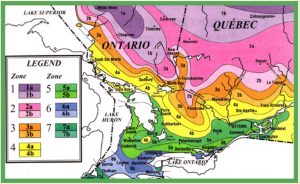
Black Cherry Tree
The black cherry tree yields large, sweet, black cherries that not only do people love, but so do the forest critters, such as robins.
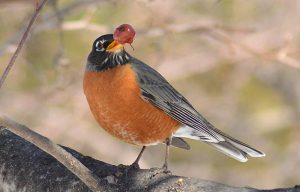
When I planted my black cherry tree, the lady at the nursery said that it was a miniature cherry tree, and that it would only grow to a height of 10 feet. Well, she was wrong.
This hardy prunus serotina fruit tree could grow up to 60 feet tall. The spotted bark and hard cherry wood, make it a delight to have in your yard. The leaves are small and shiny green, but when in bloom, the tree puts on quite a show of colour.
It needs full sun obviously for the fruit to develop and ripen on time, and it can handle a variety of wet conditions.
In Ontario, the blossoms will appear as soon as the weather starts to warm up, and if a frost condition doesn’t reappear, the fruit should be ok. You should be eating these big black sweet cherries in June or early July.
Get yourself a ladder and be prepared to have lots of visitors, because cherries can be expensive in the grocery stores.
If it is possible to keep the tree trimmed so that it doesn’t grow too high, do your trimming when the fruit season is over, so maybe in September.
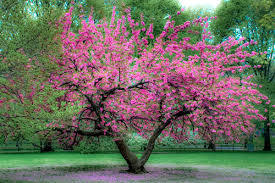
What does BeachBabyBob have to say about the Black Cherry Tree?
Bob has had a black sweet cherry tree in his yard for over 30 years. He never used pesticides on it or did anything really special to it. The tree lived a long time and the cherries were plentiful and delicious.
Here are some medicinal reasons why Bob recommends you have a black cherry tree in your backyard.
Weeping Mulberry Tree
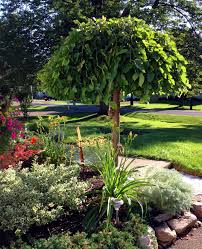
This tree is sometimes called the white mulberry. It originated in China, but because it is so hardy and quite unique, it made its way to Europe and the Americas, right to Ontario Canada.
When purchasing a weeping mulberry tree, you have 2 choices: a male (chaparral) or a female (pendula).
The male mulberry has shiny green leaves and grows to a height of 20 feet. The female bears fruit and grows to a height of 10 feet.
Here are some words to describe this tree that might help you make a decision about whether you want it in your yard …
• ornamental
• drought tolerant
• fruitful
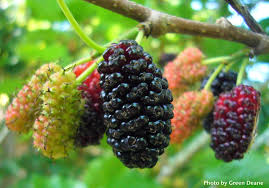
• slow growing
• messy
• adapts well to sun and shade
• umbrella shape
• deciduous
• prune to desired shape
If you purchase a female mulberry, there needs to be a male close by for fertilization if you want to have the delicious fruit. The fruit grows in clusters, and the humans and animals will love it, but it can be messy when it falls to the ground.
The male mulberry grows high and wide, and when the leaves turn yellow and fall, someone may want to rake up the leaves. (unless you live in the forest and your garden is “au natural”.
Don’t plant it close to the house because its branches and roots might give you heartaches. Besides, this tree is so shapely, you will want to make a statement to your neighbours with it, so choose its location wisely.
Prune usually at the end of the season, but this tree is so hardiy, it can handle you cutting branches almost any time. If it is female, wait until the fruit season is over.
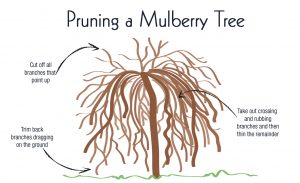
Silkworms
Spring time in China is all about silkworms and mulberry trees. Mulberry leaves are the only leaves that silkworms eat. The leaves supply water for the silkworms. The Chinese farmers collect the silkworms and use them to make silk.

What does BeachBabyBob have to say about the Weeping Mulberry?
Bob planted a male weeping mulberry over 25 years ago near his front door and driveway. What a fast growing unique narly branched tree that resembles an umbrella. The branches grow right to the ground as the summer season goes on.
In the late fall, Bob cut all the branches off and literally gives his mulberry a “brush” cut.
This seems to tell the tree to grow bigger and faster the next season. If you don’t mind leaves in the fall from this tree everywhere, plant it. It is very attractive and the birds will make nests in it.
Caution: Don’t buy the female. The berries are very messy!
Watch Nigel prune his mulberry …
Downy Serviceberry Tree
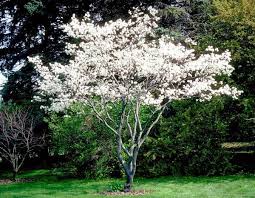
This is the friendliest tree on the block. There are different kinds of serviceberry trees, but the Downy Serviceberry is the kind that loves the southern Ontario environment, especially if you live in zone 5, not far from Toronto.
The serviceberry starts off small, simple and unobstrusive. It takes time to grow up. It can be placed almost anywhere in your garden, but I would give it some shade to protect its delicate branches, leaves, and flowers. On the other hand, it loves the sun because it will give birth to many tasty, mouth-watering berries for birds and people.
In early May, the greenery appears, followed quickly by a starry display of white flowers. The tree is strikingly beautiful, dressed in its white gown, but only for a few days.
The flowers disappear as fast as they came. For this reason, you want the tree somewhere on your property, where you will see it easily. You won’t want to miss the clouds of white bloom.
Keep your eyes open as you walk along ravines, through city parks, and pass by beautiful private gardens of people who are in the know. This admirable tree is capable of adapting to almost any location, since it is native to Canada.
It might be hiding behind stately bushes or under trees in a climaxed forest. Everything about it is like a fine wine. The leaves of green will catch your eye first and the fine branches and trunk blend into what’s around it so easily.
This “downy” tree with one trunk, can be shaped into a bush or shrub if you prefer. It is truly Canadian because it will not boss the other trees or garden plants around. It stands back and is always very polite.
If you’re every travelling in the Netherlands in the springtime, you might notice that serviceberry trees/bushes seem to be in everyone’s front yard.
It is time for all Canadians to be more proud of their countryside and own a Serviceberry tree. Now that native species is all the rage, there is no excuse. They are relatively inexpensive too.
When early September arrives, you are in for another treat. The serviceberry will present you with clusters of plummy red berries and colourful foliage of red and orange.
If you look closely, the berries resemble miniature apples because they are a member of the “pome” family, like the apple. Keep in mind that it is one of Mother Nature’s quieter creations. It might even not choose to be in the fall parade of colours.
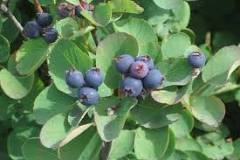
So remember when choosing a tree for your garden, choose one that is tolerant. The Downy Serviceberry is just one of BeachBabyBob’s many favourite trees. He highly recommends this tree because the birds love the fruit and it is …
shade tolerant/drought tolerant/disease tolerant/pruning tolerant/
Royal Purple Smoke Tree
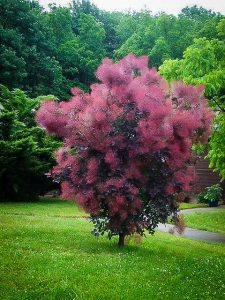
Some people call this deciduous plant a tree, and some refer to it as a bush. It comes in different colours as well.
Smoke bushes have been on the “popular” garden list for a long time in Zones 4 to 9. Thank heavens I live in zone 5, because the smoke bush is one of my very favourite plants for my garden.
It grows quickly and it uses a lot of space, so don’t plant it too close to anything else. What a powerful statement it makes! It is strong and tolerant of many factors in our environment, especially water.
It can be trimmed and shaped to your preference, but wait until the smoke puffs are gone. If you are daring and a risk taker, plant a few different colours. Cars and passerbys will definitely be watching this plant.
Size and Shape
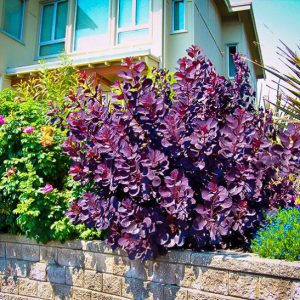
The Royal purple-pink Smoke Tree loves the sun and will grow up to 15 feet high and 15 feet wide if you don’t prune it. I like to bonsai mine by turning it into a sculpted form, but still keeping it big.
Leaves – Fruits – Flowers
With waxy green leaves to begin with in spring, the reds, purples and orange colours appear in the fall. The flowers start small and grow into clusters about 8 inches long. The plumes are the result of hairs on the infertile flowers.
The purple smoke bush is “dioecious” which means that the male and female flowers are on separate trees. The male flowers tend to be showier than the female flowers.
The misty flower sprays resemble puffs of smoke emerging from the ends of branches. These sprays are smaller than those of the exotic species (Cotinus coggygria).
The feathery flowers bloom in early spring, between April and May, and are pollinated by insects. Small greenish-white flowers are borne in 6 to 10 inches long and wide clusters.
Watch for the “drupes” which are a one-seeded indehiscent fruit with a hard bony endocarp, fleshy mesocarp, and a thin exocarp that is flexible as the cherry or dry like an almond.
Design Tips
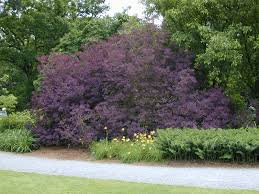
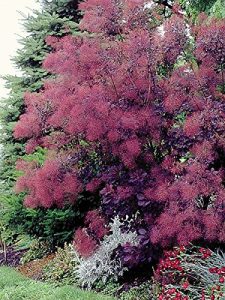
Care / Maintenance / Pruning / Disease
It propagates by cuttings and seeds. Keep your eyes on the bottom of the plant for shoots coming out in different directions from under the ground. If you plant it near a property line, trim it so it stays on your side, so that you keep the peace with your neighbour.
Its root system is fibrous and can be easily transplanted. I like to shape mine but your really don’t have to prune it. The “oblique banded leaf roller” might decide to eat your smoke.
Maybe verticillium wilt fungus with brown up your leaves or you just might be lucky enough to get leaf spot. (Just kidding!)
The Smoke tree is hardy and healthy and always happy so don’t even think about anything like stem cankers until it happens. Then check out remedies on the Net. You might have to cut it right back, but never free, Smoke tree/bush are very hardy.
Take Ken’s advice …
Tamarack or Larch Tree
The only deciduous coniferous tree we know of! What did you say? That’s impossible. Does it shed its leaves and die off in the fall and sleep for the winter and then become reborn in the spring? Or does it keep its needles and cones for the winter and just keep on going in the springtime?
Well folks … it does both and it does that really well and in such a beautiful way.

What it looks like?
Tamarack trees grow to be big, maybe even 60 feet, and it doesn’t take that long either. The bark starts out smooth and gray and then turns reddish brown and scaly as the tree grows.
The tuft needles of 10 to 20 and 2 to 3 centimetres long are soft and whimsical. Even though it looks like a conifer, it looses its needles in the Fall because it is a deciduous.
The needles go from a bluish green to a yellow before they fall. The tamarack’s seeds grow inside small light brown cones. These trees don’t produce seeds until they are 10 years old. The branches get brittle and fall easily in a wind storm.
Where is it found?
The tamarack is found everywhere in every province and territory in Canada. It especially loves the north country.
BeachBabyBob first met the tamarack in the sand dunes at Sauble Beach, along Lake Huron in Southern Ontario Canada.
He had to have one for his garden back in Cambridge as soon as he saw it, so 20 years later, he now has 2. They could be his favourite Canadian backyard tree.
Planting Tips!
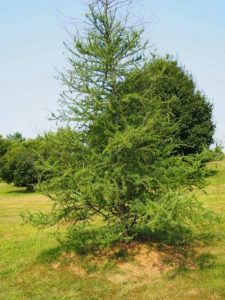
- Size: tall and pretty much thin
- Moisture: Can grow in a variety of moisture levels
- Shade: Can handle shade but prefers full sun
- Soil: Can grow in a variety of soils. BBB’s front yard larch is covered with rocks.
The tamarack is great for landscaping because of its nice shape, The fact that its needles turn a brilliant yellow in the Fall makes it a show piece.
The delicate soft needles makes you almost want to “hug” this tree. Plant it along a property line, maybe in the middle of the yard, or with other trees for contrast.
The Legend of the Tamarak
by BeachBabyBob
This is a story of a glorious tree!
At the beginning, Mother Earth created everything with a spirit. The birds, insects, fish, mammals, rocks, water, trees, and even the sky, had a spirit or a soul. Each was happy being part of Creation and living in harmony.
In the far north country in the land of Nunavut, the air was becoming colder and some animals were moving to prepare for the wild winds and the snow. A family of birds was on their journey southward, when the first great storm of winter descended upon them without warning. The north wind had just been released from the grips of summer and fall, and the wind wanted to celebrate and show its power. The birds took shelter in the majestic Tamarack trees.
These trees were the royal trees of the forest. They were bigger and taller than the other trees of the north. Their branches were filled with soft and feathery needs to keep them warm. They spent many summer days admiring themselves in the pure blue waters of the many lakes and rivers.
The first storm of the season arrived suddenly and forced the birds to take shelter in the Tamaracks. The great trees said, “No”! They told the birds that they were busy preparing for their winter’s sleep. The Tamaracks told the birds to go find another place to hide from the winds, and they closed their branches. Tired and cold, the birds were forced to fly on.
The Great Spirit was watching and became disappointed with the Tamarack Trees. She told the trees …”Because you did not give your brothers and sisters, the birds, any shelter, you too will have no protection from the storms of winter. All of your warm needles will fall to the ground as soon as the cold winds begin to blow.”
From that day on, the Tamaracks became like the leafy green trees of the south, and they were naked for the winter. As time passed, the majestic Tamaracks learned from their mistake. They decided not to grow so big and tall. They decided to become less consumed with themselves and not look for their reflection in the waters. As a result, they became stronger and more durable.
The Tamarack Trees became servants of the First Nations People. The Great Spirit was pleased and it was decided that the Tamarack trees would be given special nutrients from the spirit of the Muskeg, that would heal and help all of Mother Nature’s creations.
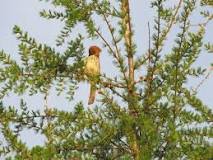
Many many years later, a man stopped to rest beneath a young Tamarack. The tree spoke to the man and told the man the story of the birds. The tree wanted to travel with the man and support him in any way possible. The young man made a walking stick from this Tamarack, and they left together.
This was the beginning of true love between Man and Nature. The Tamarack tree today is still spreading love and is always ready to help.
Bob and his wife Sue have been to Africa 4 times and their favourite tree from The Dark Continent is the Acacia tree. Listen to BeachBabyBob’s story about an African Acacia tree. Let your kids listen to this story too. They will learn to love all trees.
The Japanese Bloodgood Maple Tree
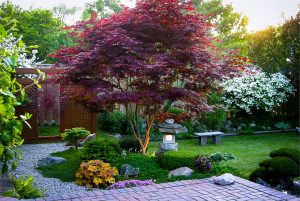
Not! The Christian Metal Band of the ’80s.
Maybe Scarlet O’Hara? You decide!
Lobes cut to the petiole
Serrated – even further toothed
Delicate leaf morphology
Top the smooth bark and undulating branches
Patio people are dumbfounded
As the tree takes on
The wispy look of smoke
Drifting
Dappled shade if you may
Moist peat and well drained soil would be nice
A slow starter – don’t despair!
After 10 years – watch out!
Expensive – Yes!
Grafting on rootstocks – Yes!
Samara seeds to full grown conversation – Yes!
Hello “acer palm a tum atro pur pur eum”
One more important video for you and your whole family to watch is this one …
Related posts:
- The History and Evolution of Gardens
- The Complete Guide To Succulent Care
- Pothos Plant Care – Your Complete Guide
- How To Move Indoor Plants Outside In The Summer (And Not Kill Them)
 |
 |
 |
 |

About Simmy Parker
Simmy is an outdoor expert who loves to spend time in the wilderness. She received a BS degree in Civil Engineering at Sacramento State University, and has put her skills to use by helping design and build some of the most impressive structures in the world. However, Simmy's true passion lies in sharing her love of nature with others, and she spends much of her free time leading hikes and teaching people about the flora and fauna that can be found all around them.
Thoughts on "Best Trees for Your Backyard Garden in Southern Ontario, Canada"
 |
 |
 |
 |
You can Get FREE Gifts. Receive Free Backyard Items here. Disable Ad Blocker to get them all now!
Once done, hit anything below
 |
 |
 |
 |